Hans Magnus Enzensberger's literary biography of Kurt von Hammerstein
Interesting review of Hans Magnus Enzenberger’s latest book in signandsight — it came out back in January & I wish I had seen the review then as I would have ordered the book right away. For one, HME is always lively & interesting (& as good a prose writer as he is a poet), and because this book, the literary biography of a German Nazi opponent, would make an excellent reading counterpoint to Jonathan Littell’s The Kindly Ones, just out in Charlotte Mandell’s splendid translation, which I am in the process of reading & hope to report on here soon.
Double life is the drug
Hans Magnus Enzensberger’s literary biography of Kurt von Hammerstein, Nazi opponent and head of the Reichswehr, is brimming with idiosyncrasy, bon mots and spectacular double lives. By Ina Hartwig
Late in life, Hans Magnus Enzensberger has familiarized himself with astonishing thoroughness with fields not formerly close to his heart: military history and German nobility. “Hammerstein oder Der Eigensinn” (Hammerstein or idiosyncrasy) is the title of a new book whose subtitle is “A German Story.” At its centre stands the narrative of Kurt von Hammerstein’s uncommonly heterogeneous family during the National Socialist era.
Hammerstein or Idiosyncrasy. A German story
Published by Suhrkamp VerlagIn the epilogue (which really ought to be read first), a 78-year-old Enzensberger asserts that he “has not written a novel”, which is accurate, albeit with qualification. In any event, his “dialogues with the dead” do give things a literary complexion. In terms of technique, Enzensberger presents himself, so to speak, as a researching litterateur.
But what is he really attempting to convey between the lines of his “German history” in terms of a wider (or as one said until fairly recently, “culturally critical”) perspective? Doubtless, this question will stimulate debate among cognoscenti of the German Resistance – and the overall line of attack is not entirely unambiguous, especially since Enzensberger to a large extent abstains from making value judgements. But he is clearly fascinated by the incontestably idiosyncratic, the intimidatingly defiant personality of Kurt Freiherr von Hammerstein-Equord (1878-1943). And from the very first line, this fascination infects the reader, who is swept vertiginously into the totalitarian historical maelstrom of the last century.
Kurt von Hammerstein, around 1934 © von Hammerstein family archive / Suhrkamp Verlag
When Adolf Hitler (ridiculed by the military nobility as “that Austrian private”) seized power in Berlin, Kurt von Hammerstein was still an influential figure, mainly as the head of the Reichswehr (the German Defence Forces, predecessor of the Wehrmacht). Together with like-minded individuals, Hammerstein attempted to derail Hitler‘s chancellorship, without effect. Just a few days later, when Hitler held his secret table talk in the presence of the heads of the Reichswehr and the navy, and moreover in Hammerstein’s official suite in the Bendlerblock complex in Berlin, it was already too late: Hitler was talking plainly about his plans for war and expansion.
For years during the Weimar Republic, Hammerstein cooperated with the Red Army, always under conditions of strict secrecy. He was acquainted, then, with its strengths, and enjoyed good relations with several Russian generals. Hitler, he knew, was insane. One year later, the 56-year-old Hammerstein, the father of seven children, was dismissed from German military service in the wake of his attempt to tender his resignation. Henceforth, he would lead the modest life of a retiree (with the exception of a couple of months when, astonishingly, he was inducted once again). At the same time, adherents of the resistance, among them Carl Goerdeler, Martin Niemöller, and Ludwig Beck, consorted in his private apartment in Dahlem.
Hammerstein’s fellow traveller Kurt von Schleicher, the last chancellor of the Weimar Republic, was murdered by the SS in the wake of so-called Röhm Putsch. Some people have been surprised by the fact that despite his openly displayed anti-Nazi attitude, Hammerstein himself was never incarcerated. Presumably, this event was prevented only by his death from cancer two years before the end of the war. Would Kurt von Hammerstein otherwise have participated in the assassination attempt on Hitler which took place on 20 July 1944 – along with two of his sons, Ludwig and Kunrat? In an interview with Der Spiegel given last week, Enzensberger offered a balanced appraisal, while mentioning that Hammerstein on several occasions expressed the view that the Germans would have to “finish eating their own soup right to the bitter end”.
His sons Kunrat, Franz und Ludwig and youngest daughter Hildur
© von Hammerstein family archive / Suhrkamp VerlagNo matter how speculative the question, the answer is inevitable: unlike several of his offspring, Hammerstein was not during his lifetime a protagonist of the resistance. He can hardly have become one post mortem. To be sure, Hammerstein’s idiosyncrasy, as depicted delightedly by Enzensberger, does the general credit. But even if writer and filmmaker Alexander Kluge has elevated the concept to the highest imaginable status (in his book “Geschichte und Eigensinn” or history and idiosyncrasy – ed.), idiosyncrasy is hardly viable as a historical category.
It is significant that in his striking and sobering study of the German nobility during National Socialism (“Vom Führer zum König” or from führer to king, 2003), historian Stephan Malinowski singled out two daughters of the Freiherr von Hammerstein as instances of “exceptional aristocratic biographies“. Already during the Weimar Republic, they sympathized with communism, turning away from the parental home in order to gain experience in working-class urban districts. Even this was not enough for them: both began relationships with Jewish Communists, and at least occasionally funnelled information to the Comintern in Moscow.
Kurt von Hammerstein’s wife Maria with their daughters Marie Luise, Maria Therese and Helga, around 1918
© von Hammerstein family archive / Suhrkamp VerlagThese daughters were Marie Luise (1908-1999) and Helga von Hammerstein (1913-2001). In the late 1920s, the first became involved with Werner Scholem, brother of the famous Gershom. Werner Scholem was shot by an SS officer at Buchenwald in 1940. Helga, in turn, was in a relationship with Leo Roth, whose danger-filled story came to an end in Stalin’s dungeons. Roth worked under various conspiratorial names for the M Apparat of the Comintern; he must have been a gifted snitch, as Herbert Wehner has attested – and one that flits through Enzensberger’s book like an uncanny spirit. In exile in Moscow, Leo Roth was shot in Lubyanka prison during the notorious “purges” of 1936. Another daughter, Maria Therese (1909-2000), not named by Malinowski, was less ideologically susceptible than her sisters, although she did sympathize with left wing views, and in particular with the educated middle class Jewry; she was the family’s sole emigre.
This absolutely unconventional break with conservative family tradition on the part of the Hammerstein daughters – which the family itself apparently endured with fortitude – is the genuinely explosive element here (it has all the makings of a thriller), and one from which Enzensberger’s book profits greatly.
One of the advantages of taking up the striking Hammerstein narrative so recently (for Enzensberger is not the first to have done so) is that some archives became newly accessible following the collapse of the Soviet Union. These materials were available for study at least for a certain period after 1989, if only to those who managed to persuade the archive staffs.
Among those who succeeded is Reinhard Müller, a historian at the Hamburg Institute For Social Research and a profound expert in communism’s institutions. Enzensberger refers explicitly to their collaboration. Among Müller’s spectacular discoveries is the “unofficial minutes“ of Hitler’s speech of February 3. This transcript (although it exists in additional versions, this is the most complete) is found in Moscow’s former Central Party Archive and is dated 6 February 1933.
How did Hitler’s secret speech make its way, in just three days, from Hammerstein’s bureau to the offices of the Moscow Comintern? Via radio, that much has been established. The rest remains shrouded in mystery. Did Hammerstein leave the notes of the speech lying around instead of securing them in a safe, allowing his daughter to copy and forward them? In one of his “dialogues with the dead”, Enzensberger confronts Kurt von Hammerstein with this very question:
“Presumably, Herr General, such an operation would have been impossible without your silent complicity. Could it be that you were pursuing political objectives? Given your good connections with the Russians, it seems plausible enough. In any event, Hitler’s speech did serve to warn the Moscow leadership.”
Hammerstein’s fictive reply: “Nonsense. I engineered nothing of the kind. And regarding my relationship to my daughter, I owe no one an explanation. Even when speaking to the Gestapo, I avoided saying anything at all on the matter.”
The Hammerstein family style oscillated between understatement, cheekiness, and brusqueness; idiosyncrasy is indeed the right word. The book virtually teams with confirmatory bon mots and anecdotes.
In the glosses and in the “dialogues with the dead”, Enzensberger’s personal voice is distinctly audible. And if the glosses (concerning the “Russian see-saw”, the scandal of the anachronistic character and high fertility of the nobility) are not entirely free of commonplaces, then the “dialogues with the dead” make an uncommonly lively impression. Enzensberger shapes the diverse characters of his interlocutors with imagination and empathy; the results are both elegantly fashioned and a genuine pleasure to read.
Ruth von Mayenburg
© “Ruth von Mayenburg, Blaues Blut und rote Fahnen” (blue blood and red flag) / Suhrkamp VerlagThe author has a special relationship to one of these departed individuals, the Bohemian noblewoman Ruth von Mayenburg (1907-1993). She too led a spectacular double life, as a glamorous society lady and a Red Army major. As she confides to Enzensberger over ginger tea, she was “slightly in love” with Hammerstein, who she refers to as a “marvellous man”. The two shared a passion for the hunt, and when the already retired general, then ailing, learned that his girlfriend was spying for the Red Army, he seemed astonishingly unsurprised. Replying to a perplexed Enzensberger, Ruth von Mayenburg says: “My dear friend, have you never had any experience with drugs? … With a risky drug, one that turns your life upside down and liberates you from boredom? That was communism for me.”
Additional personalities could also be mentioned here, including Hammerstein’s sons Ludwig and Kunrat, who remained in hiding until the end of the war after the unsuccessful assassination attempt, or a “mole” who worked in the Bendlerblock. One could also relate the subsequent fates of the daughters, who settled after the war in the USA, the GDR, and West Germany, respectively. One additional individual must be mentioned, because she stands in the background as a singularly luminous figure, namely Maria von Hammerstein, (nee von Lüttwitz 1886-1970), Kurt von Hammerstein’s wife and the mother of their children. Enzensberger does not try to make her talk from her grave, as if her style of idiosyncrasy refused to be conveyed as verbal statements.
She married the impoverished Hammerstein against the wishes of her own father, a general of the old school, and provided for their throng of children on her own for many years, apparently developing a lifestyle of virtuosic chaos. After the war, Maria von Hammerstein lived in Dahlem on her widow’s pension. Her eldest daughter Marie Luise, who settled in East Berlin where she worked as an attorney, visited her regularly, bringing bags of freshly pressed orange juice which she sewed into her coat. When a park attendant reproached the elderly lady for strolling barefoot on the lawn in the early morning, a forbidden practice, she is said to have countered with: “Good heavens, my boy, you’re awfully narrow minded.”
Daughter Maria Therese 1932/33.
© von Hammerstein family archive / Suhrkamp VerlagWhat a shame not everyone in Germany thought that way, then we might have spared ourselves “68“… Is this really what Hans Magnus Enzensberger, the former left-wing rebel, means to suggest in the end? Unmistakable, in any event, is his sympathy for an aristocratic milieu that survived the vagaries of history. He avoids precisely that which his generation prized so highly: soul searching. For him, the characteristic “silence of the Hammersteins” is no reason to be dispirited (the general is said never to have spoken a word at the dinner table). On the contrary: “There remains an unspoken remainder which no biography is capable of unravelling; and perhaps it is precisely this remainder upon which everything depends.”
As formulas go, this conclusion – derived from this lunatic precipitate of German history and offered up now to the reader – is peculiarly evasive and feeble. All the same, the book remains difficult to resist. With his literary family biography of the Hammersteins, Enzensberger really has achieved a coup.
*
This article originally appeared in the Frankfurter Rundshau on 10 January, 2008.
Hans Magnus Enzensberger, considered Germany’s most important living poet, is also a highly regarded essayist, journalist, dramatist, editor, publisher, and translator. Born in 1929 in Bavaria, he was educated in German universities and also the Sorbonne in Paris.Enzensberger’s books include “Lighter Than Air: Moral Poems”, “Zig-Zag: The Politics of Culture and Vice Versa”, and the mathematical adventure “The Number Devil”. The most recent volume of his poems to be translated (by Michael Hamburger) into English is “Kiosk”, published in 1997.
Ina Hartwig is the editor of the literature section of the Frankfurter Rundschau.
Translation: Ian Pepper
Get the signandsight newsletter for regular updates on feature articles.
signandsight.com – let’s talk european.







 “Interglacial Narrows (Poems 1915-2021)” Contra Mundum Press
“Interglacial Narrows (Poems 1915-2021)” Contra Mundum Press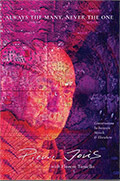 “Always the Many, Never the One: Conversations In-between, with Florent Toniello” Contra Mundum Press
“Always the Many, Never the One: Conversations In-between, with Florent Toniello” Contra Mundum Press “Conversations in the Pyrenees”
“Conversations in the Pyrenees”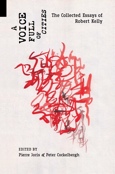 “A Voice Full of Cities: The Collected Essays of Robert Kelly.” Edited by Pierre Joris & Peter Cockelbergh
“A Voice Full of Cities: The Collected Essays of Robert Kelly.” Edited by Pierre Joris & Peter Cockelbergh “An American Suite” (Poems) —Inpatient Press
“An American Suite” (Poems) —Inpatient Press “Arabia (not so) Deserta” : Essays on Maghrebi & Mashreqi Writing & Culture
“Arabia (not so) Deserta” : Essays on Maghrebi & Mashreqi Writing & Culture “Barzakh” (Poems 2000-2012)
“Barzakh” (Poems 2000-2012) “Fox-trails, -tales & -trots”
“Fox-trails, -tales & -trots”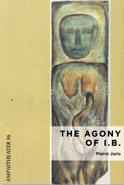 “The Agony of I.B.” — A play. Editions PHI & TNL 2016
“The Agony of I.B.” — A play. Editions PHI & TNL 2016 “The Book of U / Le livre des cormorans”
“The Book of U / Le livre des cormorans”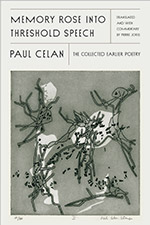 “Memory Rose Into Threshold Speech: The Collected Earlier Poetry of Paul Celan”
“Memory Rose Into Threshold Speech: The Collected Earlier Poetry of Paul Celan”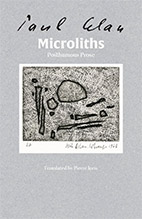 “Paul Celan, Microliths They Are, Little Stones”
“Paul Celan, Microliths They Are, Little Stones”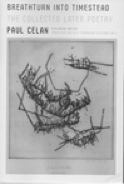 “Paul Celan: Breathturn into Timestead-The Collected Later Poetry.” Translated & with commentary by Pierre Joris. Farrar, Straus & Giroux
“Paul Celan: Breathturn into Timestead-The Collected Later Poetry.” Translated & with commentary by Pierre Joris. Farrar, Straus & Giroux